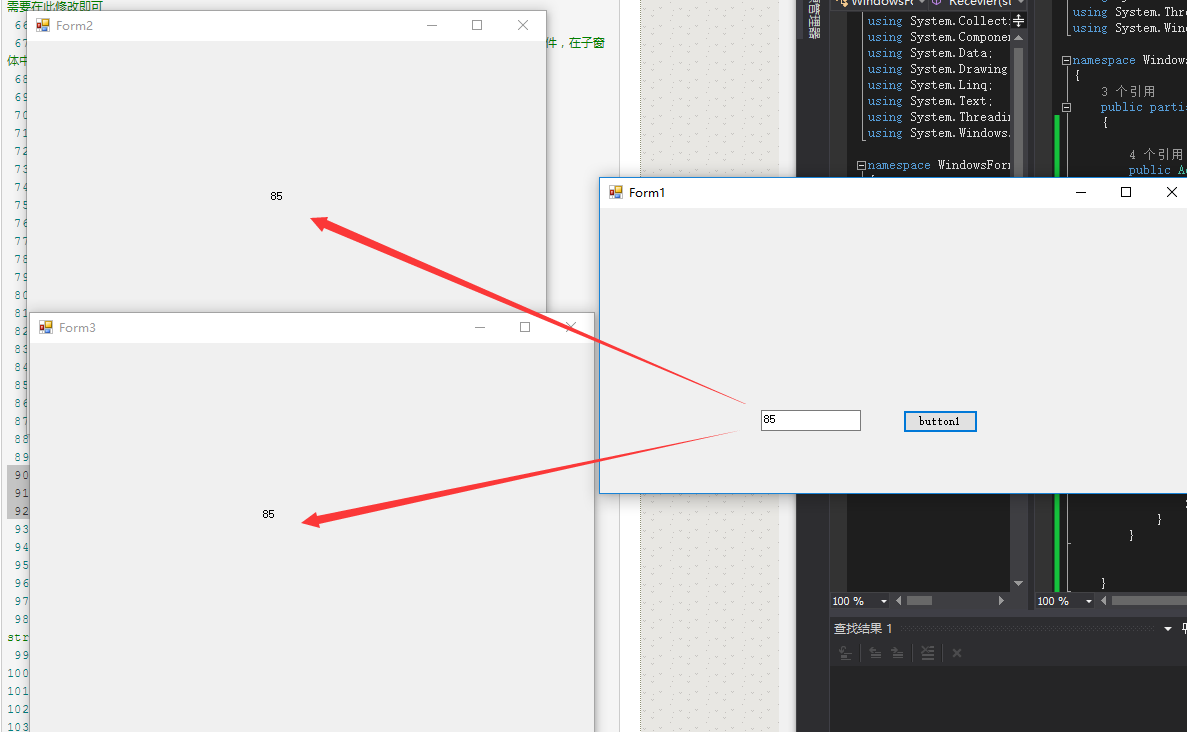两个子窗口向一个主窗口发送信息
主窗口:
using System; using System.Collections.Generic; using System.ComponentModel; using System.Data; using System.Drawing; using System.Linq; using System.Text; using System.Threading.Tasks; using System.Windows.Forms; namespace WindowsFormsApplication1 { public partial class Form1 : Form { public Form1() { InitializeComponent(); Form2 fm2 = new Form2(); fm2.msgSender = this.Receiver; //[3]将委托对象和方法关联 fm2.Show(); Form3 fm3 = new Form3(); fm3.msgSender = this.Receiver; //[3]将委托对象和方法关联 fm3.Show(); } //[2]根据委托定义方法完成数据传递 public void Receiver(string info) { this.label2.Text = info; } } //[1]声明委托,一般定义在外面 public delegate void ShowInfo(string param); }
子窗口1:
using System; using System.Collections.Generic; using System.ComponentModel; using System.Data; using System.Drawing; using System.Linq; using System.Text; using System.Threading.Tasks; using System.Windows.Forms; namespace WindowsFormsApplication1 { public partial class Form2 : Form { public Form2() { InitializeComponent(); } //创建委托对象 public ShowInfo msgSender; //通过委托传递数据 private void button1_Click(object sender, EventArgs e) { msgSender(this.textBox1.Text); } } }
子窗口2:
using System; using System.Collections.Generic; using System.ComponentModel; using System.Data; using System.Drawing; using System.Linq; using System.Text; using System.Threading.Tasks; using System.Windows.Forms; namespace WindowsFormsApplication1 { public partial class Form3 : Form { public Form3() { InitializeComponent(); } //创建委托对象[从到主] public ShowInfo msgSender; private void button1_Click(object sender, EventArgs e) { msgSender(this.textBox1.Text); } } }
主窗口向两个子窗口发送信息

上代码~~~~~~~~~~
主窗口:
using System; using System.Collections.Generic; using System.ComponentModel; using System.Data; using System.Drawing; using System.Linq; using System.Text; using System.Threading.Tasks; using System.Windows.Forms; namespace WindowsFormsApplication1 { public partial class Form1 : Form { public Action<string> SendMsg { get; set; } public Form1() { InitializeComponent(); Form2 fm2 = new Form2(); SendMsg += fm2.Recevier; fm2.Show(); Form3 fm3 = new Form3(); SendMsg += fm3.Receiver; //[3]将委托对象和方法关联 fm3.Show(); } private void button1_Click(object sender, EventArgs e) { if (SendMsg != null) { SendMsg(this.textBox1.Text);//执行所有注册的委托 } } } }
子窗口1:
using System; using System.Collections.Generic; using System.ComponentModel; using System.Data; using System.Drawing; using System.Linq; using System.Text; using System.Threading.Tasks; using System.Windows.Forms; namespace WindowsFormsApplication1 { public partial class Form2 : Form { public Form2() { InitializeComponent(); } public void Recevier(string info) { this.label1.Text = info; } } }
子窗口2:
using System; using System.Collections.Generic; using System.ComponentModel; using System.Data; using System.Drawing; using System.Linq; using System.Text; using System.Threading.Tasks; using System.Windows.Forms; namespace WindowsFormsApplication1 { public partial class Form3 : Form { public Form3() { InitializeComponent(); } public void Receiver(string info) { this.label1.Text = info; } } }